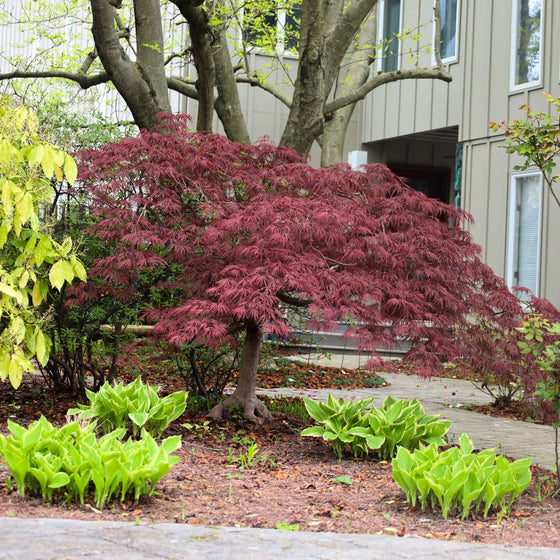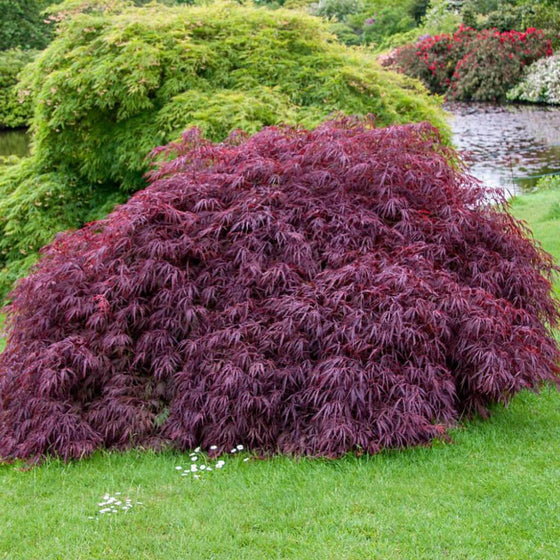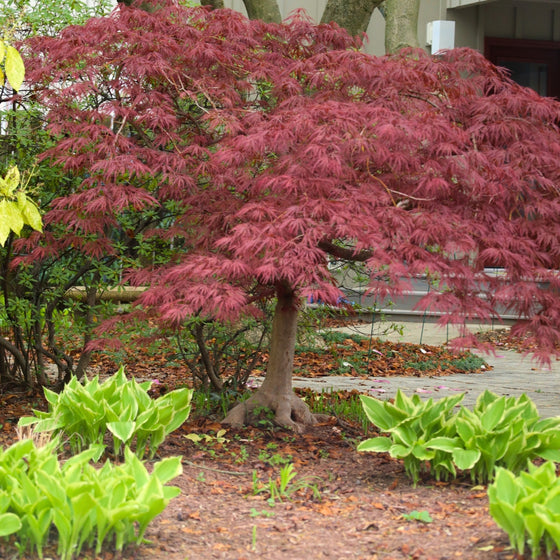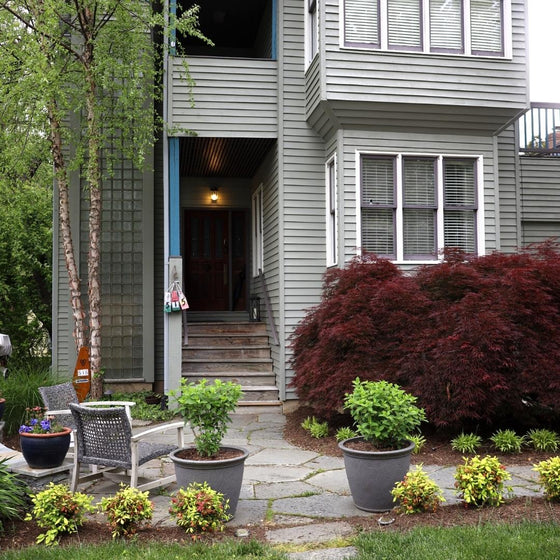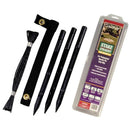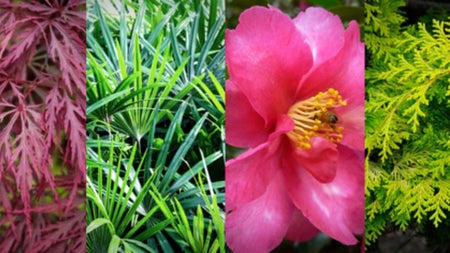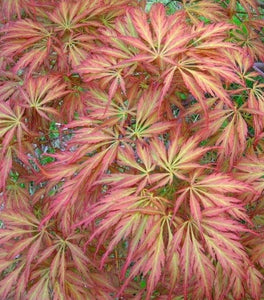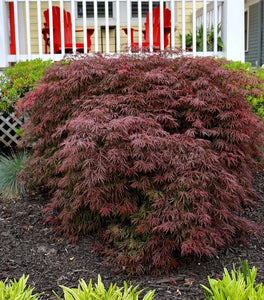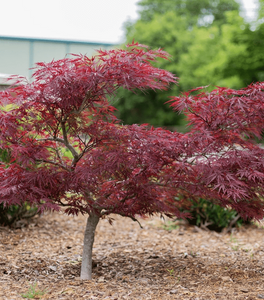
Images Depict Mature Plants
Tamukeyama Japanese Maple Trees
The Tamukeyama Japanese Maple (Acer palmatum 'Tamukeyama') is a breathtaking ornamental tree that enhances any garden with its striking, finely dissected leaves and graceful, cascading form. Known for its vibrant deep red to burgundy foliage, this weeping Japanese maple offers year-round interest, turning brilliant shades of crimson in the fall. Its unique, lace-like leaves create a delicate, airy appearance, while its arching branches provide a dramatic waterfall effect, making it a perfect focal point in any landscape. Ideal for small gardens, rock gardens, or Japanese-inspired designs, the Tamukeyama Japanese Maple brings elegance and texture to your outdoor space.
Thriving in partial shade to full sun, the Tamukeyama Japanese Maple is both adaptable and hardy, preferring well-drained, slightly acidic soil. It reaches a mature height of 6-8 feet, with a similar spread, making it perfect for compact spaces, container planting, or as an accent tree in larger landscapes. This versatile tree is also heat-tolerant and can withstand periods of drought, making it a great low-maintenance option for a variety of climates. Whether used as a focal point in a garden bed or paired with contrasting foliage plants, the rich red hues of the Tamukeyama provide a stunning visual impact year-round.
In addition to its aesthetic appeal, the Tamukeyama Japanese Maple is resistant to deer and requires minimal care, making it an excellent choice for gardeners seeking a beautiful yet hassle-free addition to their landscape. With its slow growth rate and compact size, this tree is perfect for small spaces, patios, or even as a statement piece in a container. Its delicate form and vibrant fall color ensure that the Tamukeyama will be a standout feature in any garden, bringing timeless beauty and tranquility to your outdoor living space for years to come.
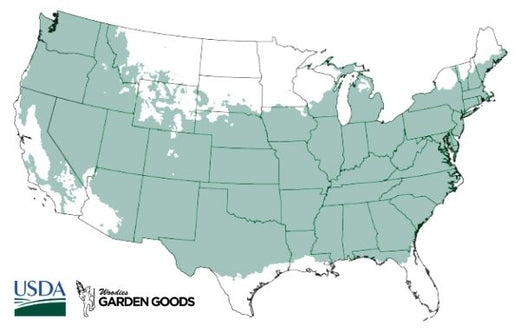
| Hardiness Zone: | 5-8 |
|---|---|
| Mature Height: | 6 to 8 feet |
| Mature Width: | 10 to 12 feet |
| Classification: | Small Deciduous Tree |
| Sunlight: | Partial to Full Sun |
| Habit: | Densely branched, Weeping |
| Foliage: | Dark Purple-Red Foliage |
| Soil condition: | Any well drained soil |
| water requirements: | Water well until established. |
| Uses: | Extremely attractive when used as a focal point, specimen planting, or in containers |
How to Care for Tamukeyama Japanese Maple
Be sure to read about the recommended care instructions to keep your Tamukeyama Japanese Maple healthy and thriving for years to come!
How do I Plant my Tamukeyama Japanese Maple Tree?
To plant your Tamukeyama Japanese Maple tree, begin by selecting a location that provides partial shade to full sun, depending on your climate. In cooler regions, this tree can thrive in full sun, but in hotter climates, it is best to choose a spot with some afternoon shade to prevent leaf scorch. Tamukeyama Japanese Maple prefers well-drained, slightly acidic soil, enriched with organic matter such as compost. Start by digging a hole that is twice as wide as the root ball and just as deep to allow the roots ample room to spread comfortably. Place the tree in the hole, ensuring the top of the root ball is level with the surrounding ground, which helps prevent root rot. Backfill the hole with a mix of native soil and compost, gently firming the soil around the base to eliminate air pockets. After planting, water the tree thoroughly to help establish a strong root-to-soil connection. Once planted, adding a 2-3 inch layer of organic mulch around the base of your Tamukeyama Japanese Maple tree will help retain moisture, regulate soil temperature, and reduce weed competition. Be sure to keep the mulch a few inches away from the trunk to avoid issues like rot. During the first growing season, water your newly planted tree consistently to keep the soil evenly moist, but avoid overwatering, as Japanese Maples do not tolerate waterlogged conditions well. Proper spacing is also important—make sure to plant your Tamukeyama Japanese Maple where it has enough room to grow, as it will reach a mature height of about 6-10 feet with a spread of 8-12 feet. By planting with care and providing proper initial care, your Tamukeyama Japanese Maple will thrive and bring cascading, deep red foliage and graceful structure to your garden for years to come.
How do I Water my Tamukeyama Japanese Maple Tree?
Watering your Tamukeyama Japanese Maple tree properly is essential to maintain its vibrant red foliage and ensure healthy growth. During the first year after planting, it is crucial to water deeply and consistently to establish a strong root system. Aim to water your Tamukeyama Japanese Maple one to two times a week, depending on weather conditions, ensuring that the soil remains consistently moist but not waterlogged. Deep watering encourages roots to grow deeper into the soil, which will help the tree become more drought-tolerant in the future. Use a soaker hose or drip irrigation system to deliver water directly to the root zone while minimizing evaporation. Watering in the early morning is ideal, as it gives the tree time to absorb moisture before the heat of the day. Once established, Tamukeyama Japanese Maple trees become more drought-tolerant, but it is still important to water during extended dry spells or hot weather. Check the soil regularly to determine when watering is needed—if the top 2 to 3 inches feel dry to the touch, it's time to water. Adding a 2-3 inch layer of organic mulch around the base of the tree can help retain soil moisture, reduce evaporation, and regulate soil temperature, particularly during the summer months. Be sure to keep the mulch a few inches away from the trunk to prevent rot and improve airflow. Proper watering practices will ensure that your Tamukeyama Japanese Maple remains healthy and produces lush, cascading red foliage, enhancing your landscape all season long.
How do I Fertilize my Tamukeyama Japanese Maple Tree?
Fertilizing your Tamukeyama Japanese Maple tree is essential for supporting healthy growth, vibrant foliage, and a strong root system. The best time to fertilize your Tamukeyama Japanese Maple is in early spring, just before new growth begins. Use a balanced, slow-release fertilizer, such as a 10-10-10 or a 12-4-8 blend, which provides the necessary nutrients like nitrogen, phosphorus, and potassium. Spread the fertilizer evenly around the drip line—the area directly below the outermost branches—where the feeder roots are most active. Make sure not to place the fertilizer too close to the trunk to avoid root burn. After applying the fertilizer, water the tree thoroughly to help the nutrients reach the root zone effectively and support healthy development throughout the growing season. For additional soil health and long-term growth benefits, consider using organic compost around the base of your Tamukeyama Japanese Maple. Compost provides a slow, steady release of nutrients, improves soil structure, and helps with moisture retention, creating an ideal growing environment. Avoid over-fertilizing, as too much nitrogen can lead to weak growth and negatively impact the vibrant red coloration of the foliage. Typically, fertilizing once a year in early spring is sufficient, but if the soil is particularly nutrient-deficient, a light application in mid-summer can be helpful. With proper fertilization, your Tamukeyama Japanese Maple tree will thrive, producing beautiful cascading branches and deep red foliage that enhances your landscape throughout the year.

How do I Prune my Tamukeyama Japanese Maple Tree?
Pruning your Tamukeyama Japanese Maple tree is essential for maintaining its beautiful, cascading form and encouraging healthy growth. The best time to prune Tamukeyama Japanese Maple is in late winter or early spring, just before new growth starts, while the tree is still dormant. Begin by using clean, sharp pruning shears to remove any dead, damaged, or diseased branches, as this will improve the overall health of the tree and reduce the risk of pests or disease. It is also helpful to thin out any branches that cross or grow inward, as these can lead to overcrowding and reduce air circulation. When pruning, focus on enhancing the tree's natural, weeping shape, and be careful to make clean cuts just above a bud or branch junction. Throughout the growing season, light pruning can be performed to maintain the tree's desired size and shape. Avoid heavy pruning, as Tamukeyama Japanese Maple has a naturally graceful form that looks best when left relatively intact. You may trim back any errant branches that disrupt the overall appearance or thin out overly dense areas to allow sunlight to reach the inner branches. However, avoid cutting into older wood, as Japanese Maples do not regenerate well from old branches, and excessive pruning can lead to sparse growth. Proper pruning techniques will allow your Tamukeyama Japanese Maple tree to flourish, showcasing its stunning, cascading branches and deep red foliage that provide elegance and color throughout the year.

